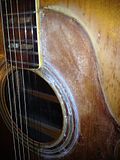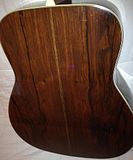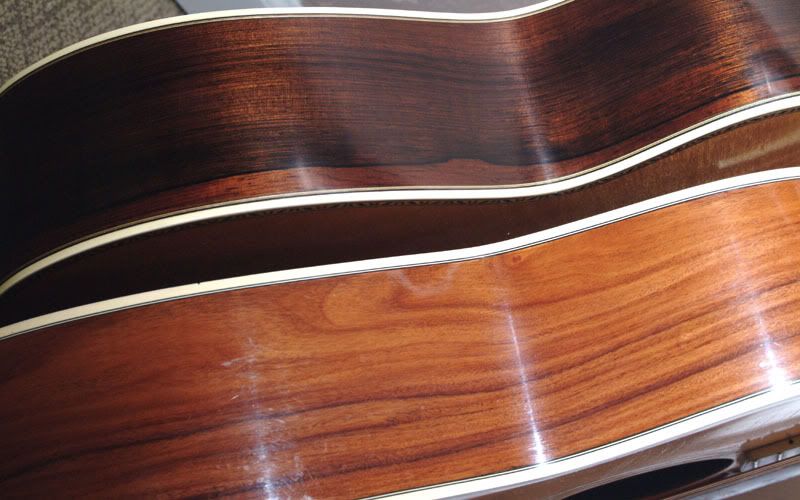
 |
|
#1
|
|||
|
|||
|
Hi,
This is a Yamaha FG300...the pickguard long gone of course, but what might I use to clean this hardened "gunk" around where the guard was? I hope it's not some old epoxy or something. And why the heck isn't there someone in business making the exact, decorated replacement pickguards for these? Seems like everyone's always asking. Anyway, take a look and let me know what you think:  Also, can the "blushing" be cleared up or no?  Finally, what type of wood was this (I know it's only the top laminate):  Thank you all! |
|
#2
|
|||
|
|||
|
The preservation polish from StewMac may get the gunk off, but I'm not sure. I assume you've tried water and it doesn't dissolve?
Looks like Brazilian rosewood on the back. |
|
#3
|
|||
|
|||
|
Hmmm...I'll have to look into that polish. I should have added that naphtha didn't touch the gunk. It's pretty crusty and hard, and I think I've seen it on other FG300s that lost their pickguards, but not as much as here.
Are these nitrocellulose finishes on these old Yamahas? I just now read about a spray product from Mohawk Finishing that you can apply to get rid of the blush if it's nitrocellulose. It that's even a blush in the picture, I'm not sure. It's under the wood. Also, I don't think they used any BRW laminates for these guitars...there was some other wood with an odd name that looks like BRW and that's what I was trying to figure out. But I could be wrong, maybe it is a BRW laminate. Looks cool in any case. Thank you. Last edited by acme97; 05-22-2014 at 06:31 PM. |
|
#4
|
||||
|
||||
|
HI
In my former life I was known as Yamaha Junkie (the moniker drew 100's and hundreds of Yamaha questions so I changed it!) The FG300 is a favorite! I had a privildged friend that was touring 3 of the Yamaha Guitar factories including Japan custom. No replacement guards are sitting on shelves over there unfortunatly. I still get 20 emails a year asking where to get the pickguard replacement. I could get them made but the price is nuts. Try to draw the haze out with Naptha. Might work. The finish is thick enough if it needs repolished on the surface. The whole guitar is laminated BUT not for cheap, for durability. The bracing, thickness...... is perfect to make a guitar drip honey as a player. The back and sides are Jacaranda. I have to say Yamaha used Jacaranda as a (inacurate) description for Brazilian also, likely to get around the '68 ban on Brazilian. The 300's are Jacaranda. |
|
#5
|
|||
|
|||
|
Jacaranda is just another name for brazilian rosewood used in some parts of the globe as are Pianowood, caviuna, pau puerto & obuina. All refer to Dalbergia nigra Which is what that veneer appears to be. Just wanted to clear up that they are the same wood.
|
|
#6
|
|||
|
|||
|
Have you tried Meguiars Scratch X? It won't dissolve the gunk, but might remove it without removing too much finish.
Brad
__________________
Guild F212: 1964 (Hoboken), Guild Mark V: 1975 (Westerly), Guild Artist Award: 1975 (Westerly), Guild F50: 1976 (Westerly), Guild F512: 2010 (New Hartford), Pawless Mesquite Special: 2012, 90s Epi HR Custom (Samick), 2014 Guild OOO 12-fret Orpheum (New Hartford), 2013 12 fret Orpheum Dread (New Hartford), Guild BT258E, 8 string baritone, 1994 Guild D55, Westerly, 2023 Cordoba GK Negra Pro. |
|
#7
|
|||
|
|||
|
Resisted replying to this one until I saw some other answers.
If polishing compounds and/or mild solvents don't work, you could use a scraper. I often ask myself, when puzzled about the best way to do a certain task, "Can it be done with a scraper?" I have tried many tasks of guitar building and repair with a scraper, including shaping necks, finishing wood surfaces, levelling, glue removal, and much more. The scraper is incredibly versatile and accurate when powered by a skilled hand, and it can be very forgiving in many circumstances when used carefully. As Kitchen Guitars tells us that the finish is substantially thick enough, then it can most likely be polished out with fine grade sandpaper or micro mesh pads after the gunk is removed, then finished with an automotive swirl or scratch remover.
__________________
---- Ned Milburn NSDCC Master Artisan Dartmouth, Nova Scotia |
|
#8
|
||||
|
||||
|
Quote:
 Here are many images to make my point. http://www.acousticguitarforum.com/f...d.php?t=118022 The word Jacaranda is used in various names for the Brazilian Rosewood species. A spanish? word that works into the name of Brazilian in some way. Dalbergia nigra is Brazilian Rosewood. Jacaranda Dilobos is Jacaranda. But the two trees are vastly different. Brazilian grows in a relatively small area. Jacaranda grows many places, in some circles it is also known as Pau Farrow. Stole this paragraph from the Wiki -"Jacaranda is a genus of 49 species of flowering plants in the family Bignoniaceae, native to tropical and subtropical regions of Central America, South America, Cuba, Hispaniola and the Bahamas.[1] It has been planted widely in Asia, especially in Nepal. It has been introduced to most tropical and subtropical regions. The genus name is also used as the common name." I have owned a few Brazilian guitars and a few Jacaranda guitars. Very different to look at and listen to. I have in my shop a set of Brazilian and a set of Jacaranda. They tap different, smell different, sand different, weight is different. If you are still convinced they are one and the same then I will be happy to sell you my set of Jacaranda with no run out for half what I paid for the Brazilian set. |
|
#9
|
|||
|
|||
|
Interesting points.
Regarding what I assume is the blush under the finish...since no one has stated it is not...I could try the naphtha, but was considering this product. Actually there's a couple blush areas. What do you think of this stuff: https://www.youtube.com/watch?v=4EyuNdQn-oc These vintage finishes ARE nitrocellulose, correct? Also, I guess I could carefully use a scraper on the gunk areas then buff out and polish. I was hoping to put a reasonable pickguard replacement in place, at least match the color of the original. |
|
#10
|
|||
|
|||
|
I have a few FG300 guitars. When I need a pick guard I order it from Terrapin Guitars. They fit and look pretty good.
http://www.terrapinguitars.com/ Yes, they are nitrocellulose finish.
__________________
TOO Stinkin' MANY GITS! Buncha Les Pauls Buncha Strats Martin HD-28, 2012-000CNylon Taylor 310K Taylor 214CE Taylor 110 Larrivee D-05 FG-375S FG-180 (5) FG-300 (5) FG-360 FG-350W APX-10 FG160E Woodsong K100,SW400 Paul Beard GRE Many other Yamahas (25 others- Garrison, Seagull, PRS, Squier 51, Dynamic) BigMike sez: I tried to be good, but there were just too many options. |
|
#11
|
|||
|
|||
|
Quote:
I have seen their site. Why do some guitar repair guys prefer glue over adhesive backing for pickguards? In this case, a laminate top guitar, wouldn't adhesive backing be preferred? |
|
#12
|
|||
|
|||
|
The ones I bought had peel and stick adhesive.
__________________
TOO Stinkin' MANY GITS! Buncha Les Pauls Buncha Strats Martin HD-28, 2012-000CNylon Taylor 310K Taylor 214CE Taylor 110 Larrivee D-05 FG-375S FG-180 (5) FG-300 (5) FG-360 FG-350W APX-10 FG160E Woodsong K100,SW400 Paul Beard GRE Many other Yamahas (25 others- Garrison, Seagull, PRS, Squier 51, Dynamic) BigMike sez: I tried to be good, but there were just too many options. |
|
#13
|
|||
|
|||
|
Yes, I see that is an option. But why would someone want to use glue over an adhesive backing...and is there a difference in tone between the two methods of reinstalling the pickguard? I know that the thinner pickguard materials have less impact on tone, laminate top or not.
|
 |
|
| Tags |
| fg300, red label, yamaha |
|
|